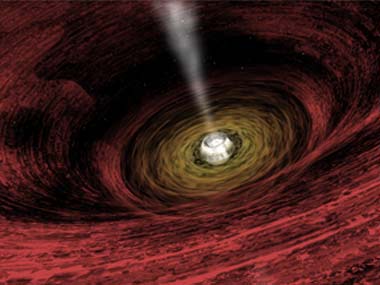Apparently, deep in outer space there is a ginormous black hole that is 12 billion times bigger than the sun. Yup, you read that right. TWELVE BILLION times larger than the sun, making it one of the most massive deep-space black holes ever recorded.
According to Political Science magazine
, in order to measure the size of the black hole, the team analysed the luminosity surrounding it. Black holes have a huge gravitational pull, and are constantly sucking in gas and other materials from nearby. This process heats up the gas so much that it emits intense energy and thermal radiation which makes it shine brightly. [caption id=“attachment_2123965” align=“alignleft” width=“380”]
 Representational image[/caption] The new black hole has been named SDSS J0100+2802, is 12.8 billion light years from Earth and was formed just 900 million years after the Big Bang,
according to the Telegraph
. Scientists say they have discovered a black hole so big that it challenges the theory about how they grow. Scientists said this black hole was formed about 900 million years after the Big Bang. But with measurements indicating it is 12 billion times the size of the Sun, the black hole challenges a widely accepted hypothesis of growth rates. “Based on previous research, this is the largest black hole found for that period of time,” Dr Fuyan Bian, Research School of Astronomy and Astrophysics, Australian National University (ANU), told Reuters on Wednesday. “Current theory is for a limit to how fast a black hole can grow, but this black hole is too large for that theory.” The creation of supermassive black holes remains an open topic of research. However, many scientists have long believed the growth rate of black holes was limited. Black holes grow, scientific theory suggests, as they absorb mass. However, as mass is absorbed, it will be heated creating radiation pressure, which pushes the mass away from the black hole. “Basically, you have two forces balanced together which sets up a limit for growth, which is much smaller than what we found,” said Bian. The black hole was discovered a team of global scientists led by Xue-Bing Wu at Peking University, China, as part of the Sloan Digital Sky Survey, which provided imagery data of 35 percent of the northern hemisphere sky. The ANU is leading a comparable project, known as SkyMapper, to carry out observations of the Southern Hemisphere sky. Bian expects more black holes to be observed as the project advances. (With inputs from Reuters)
Representational image[/caption] The new black hole has been named SDSS J0100+2802, is 12.8 billion light years from Earth and was formed just 900 million years after the Big Bang,
according to the Telegraph
. Scientists say they have discovered a black hole so big that it challenges the theory about how they grow. Scientists said this black hole was formed about 900 million years after the Big Bang. But with measurements indicating it is 12 billion times the size of the Sun, the black hole challenges a widely accepted hypothesis of growth rates. “Based on previous research, this is the largest black hole found for that period of time,” Dr Fuyan Bian, Research School of Astronomy and Astrophysics, Australian National University (ANU), told Reuters on Wednesday. “Current theory is for a limit to how fast a black hole can grow, but this black hole is too large for that theory.” The creation of supermassive black holes remains an open topic of research. However, many scientists have long believed the growth rate of black holes was limited. Black holes grow, scientific theory suggests, as they absorb mass. However, as mass is absorbed, it will be heated creating radiation pressure, which pushes the mass away from the black hole. “Basically, you have two forces balanced together which sets up a limit for growth, which is much smaller than what we found,” said Bian. The black hole was discovered a team of global scientists led by Xue-Bing Wu at Peking University, China, as part of the Sloan Digital Sky Survey, which provided imagery data of 35 percent of the northern hemisphere sky. The ANU is leading a comparable project, known as SkyMapper, to carry out observations of the Southern Hemisphere sky. Bian expects more black holes to be observed as the project advances. (With inputs from Reuters)
Astronomers find black hole 12 billion times bigger than the sun
FP Staff
• February 26, 2015, 19:20:54 IST
Apparently, deep in outer space there is a ginormous black hole that is 12 billion times bigger than the sun. Yup, you read that right. TWELVE BILLION times larger than the sun, making it one of the most massive deep-space black holes ever recorded.
Advertisement
)
End of Article